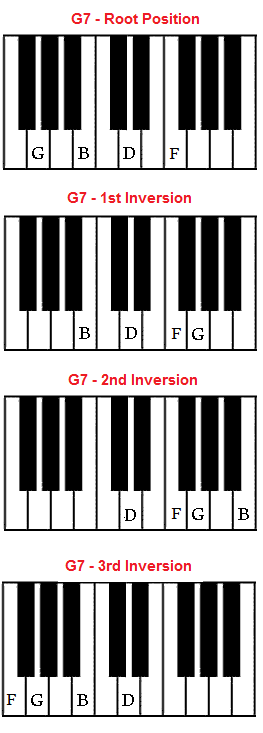The G7 chord is a very popular one on piano. Naturally it’s because the G chord is chord V in the key of C, the most popular key on piano. The key of C is perhaps the easiest to play. The C major scale makes use of the white piano keys, no sharps or flats (black keys). If you play G7, you get a strong feeling to play another chord right after. This chord is a perfect fourth above G and is the chord C. So usually, when the G seventh chord is played, the chord C follows right after. This is not a must but is the normal way to play a chord progression.
To learn more about this chord and others, check out my course, Piano Chords: How To Form Basic Chords On Piano And Keyboard.
How do you form a G7 chord? You combine the root, major third, perfect fifth, and flat seventh of the G major scale. The G major scale is made up of the notes G A B C D E F#. To form the chord, G7, you play the notes G, B, D and F. Note clearly that you do not play F sharp, instead you play the note, F which is a semitone lower than F sharp.
In terms of intervals, the G dominant 7 chord is made up of a major third, followed by two minor thirds. G to B consists of two tones, a major third. B to D interval consists of one and a half tones, a minor third. And D to F consists of one and a half tones, as well, a minor third.
There are other names for the chord, G7 (other ways in which the chord is written). These are G dominant 7 and G dom7.
What is the right hand fingering for the G dominant seventh chord. The first finger (thumb) plays G, second finger plays B, third finger plays D, and fifth finger plays F.
The diagram below shows you the notes of the G seven chord in root position, first, second and third inversions.
Inversions
Until now, we’ve only looked at the G7 chord in root position. In root position the sequence of pitches for this chord is G-B-D-F. What if the note G is raised by one octave? If G is raised this takes us to the first inversion of the chord and the pitches are in the sequence B-D-F-G. If we raise B one octave higher the sequence of notes now becomes D-F-G-B, which is the second inversion of the G seventh chord. Lastly in the third inversion we raise D by one octave and it takes us to F-G-B-D. In each inversion or voicing, the notes G, B, D and F are all played. The only difference is the sequence of the pitches.
For more information on constructing piano chords, return from G7 chord to main piano chords page. You can learn how to form all kinds of piano chords there, in all 12 keys.
I highly recommend Rocket Piano and Piano For All for learning how to play piano. Check out my piano lessons course review here. Learn about my favorite course for learning how to play piano and keyboards.